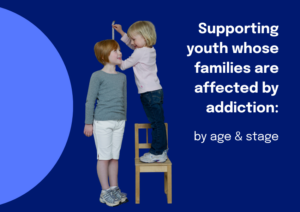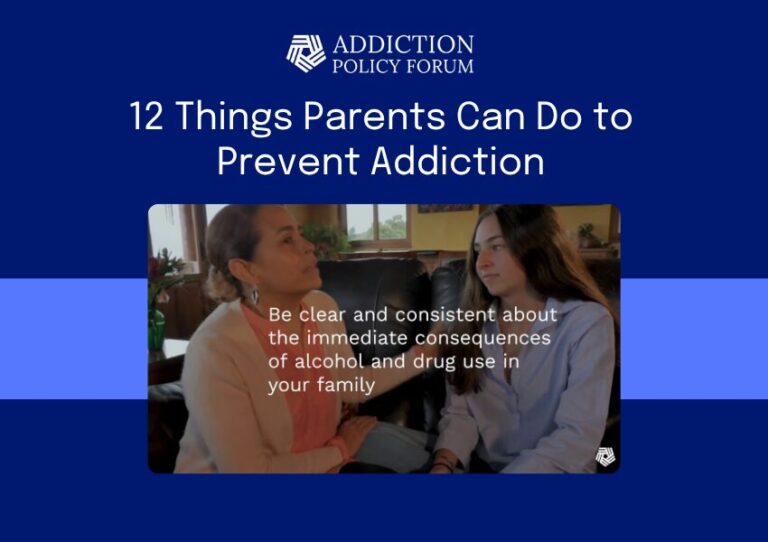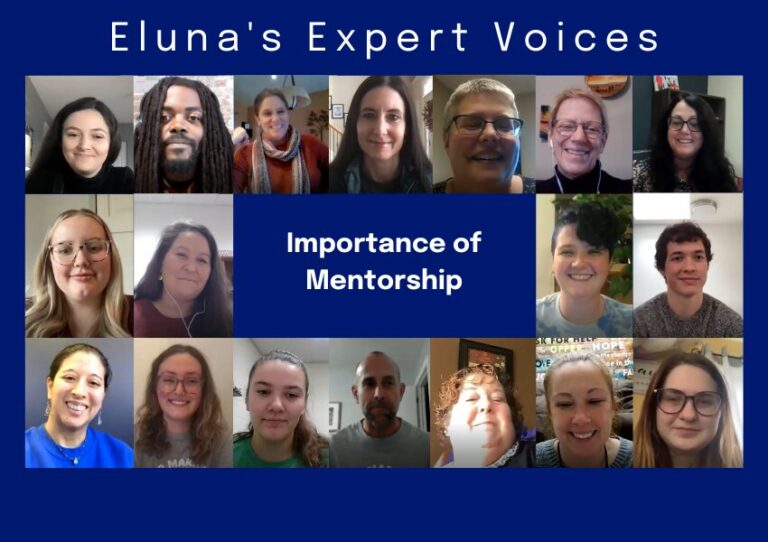Supporting youth whose families are affected by addiction: by age & stage
 Navigating a family member’s substance use disorder can be challenging at any age. However, child development theory and research tell us that children process stressful events differently based on their unique developmental stage.
Navigating a family member’s substance use disorder can be challenging at any age. However, child development theory and research tell us that children process stressful events differently based on their unique developmental stage.
Consider a pair of siblings ages 5 and 15 years old who are affected by their parent’s substance use disorder. While the siblings might experience similar emotions of anxiety, sadness, and guilt, their methods of communicating and managing those emotions would be very different. Similarly, a mentor explaining the parent’s substance use disorder would need to use very different language when talking to the 15-year-old compared to the 5-year-old. This article will review common trauma responses followed by tips for education, prevention, and mentoring at each developmental stage.
This information is based on child development and psychology research, but it’s important to note that research often leaves out marginalized groups. Children from minority cultural or religious backgrounds may have different responses and needs in the face of traumatic events. Children with developmental disabilities may not match the typical expectations for their chronological age. Even children who are not diagnosed with a developmental disability may experience developmental regression as a trauma response. If you are reading this article with a specific young person in mind, remember that these general guidelines may not accurately reflect the experience of each individual.
Jump to: Infants & Toddlers – Preschoolers – Early Elementary – Preteens – Teens
- Education: Infants and toddlers may not have reached the cognitive level necessary to understand the ins and outs of substance use disorder, but this is a great age to start teaching the building blocks of emotional literacy. Kids who can identify and communicate their emotions will be better equipped to manage the stress of a family member’s substance use disorder. You can model emotional literacy by labeling your and your child’s emotions and identifying coping strategies:
“It looks like you’re feeling sad that Mommy left! I can give you a hug to help you feel better.”
“I see that you’re angry – you don’t want your diaper changed! I have to change your diaper to keep you healthy and safe, but you can have your pacifier while we get changed.”
- Prevention: Keep substances out of sight and out of reach. Encourage good decision-making skills by offering positive choices (e.g. which clothes to wear, which book to read before bedtime). Model and talk about the things we do to take care of our bodies.
- Possible trauma responses: Infants and toddlers are not yet able to verbalize challenging feelings related to a family member’s substance misuse, so it’s important to look for behavioral cues. Here are some possible trauma responses for this age group: Increased fussiness, heightened startle response, difficulty soothing, changes in sleeping patterns, changes in appetite, digestive problems, withdrawal, and clinginess. [Sources 1, 2, 3]
- Mentoring & Support: Encourage healthy attachment to adult caregivers by responding to baby’s needs, engaging in play & conversation, and offering frequent opportunities for positive touch. Youth and families affected by the disease of addiction may also become isolated from communities of support. Here are some recommended programs that focus on caregiver support to help bridge and rebuild connections:
- CheckDEC: A free mobile app that immediately connects children, families, and professionals to substance abuse-related information, crisis helplines, drug and treatment information, supportive resources, and services within their local area. Brought to you by the National Alliance for Drug Endangered Children and Office for Victims of Crime
- Parents of Addiction Loved Ones (PAL): Parents with an adult child dealing with substance use disorder involving either drugs or alcohol can find hope and support through Parents of Addicted Loved Ones (PAL). Meetings are available all over the country.
- Education: Preschool-aged kids are starting to develop concepts of health and illness. They may not always understand why an illness happens, and they are still developing the cognitive skills to recognize connections between healthy behaviors and good long-term health outcomes. [Sources 7, 8] You can explain to your preschooler that their family member has an illness, then reassure them that this illness is not contagious and not their fault. For an age-appropriate conversation starter, try the book Lambi Learns About Addiction or check out the others on this list.
“Dad has a sickness that makes him feel like he needs to take drugs or alcohol (a grown-up drink) to feel okay. Taking too much of these can make Dad’s body feel sick or make him act differently.”
“You can’t catch Dad’s sickness like you can catch a cold or the flu. It’s not your fault that Dad is sick.”
- Prevention: Talk about safe ways to take medicine, model and discuss healthy behaviors, encourage independent problem-solving, point out dangerous substances, and use make-believe stories to discuss how violence and unhealthy behavior can hurt people. For more, see Prevention Tips for Every Age.
- Mentoring: Research tells us that connecting with a caring adult mentor is one of the best strategies for prevention and support for children affected by a family member’s substance misuse, and kids who connect with a mentor earlier in life get the most benefit. [Sources 9, 10, 11] To search for a mentor near you, check out Mentor: The National Mentoring Partnership.
- Possible trauma responses: Young children will have trouble understanding & verbalizing challenging feelings related to a family member’s substance misuse, so it’s important to look for behavioral cues. Here are some possible trauma responses to look out for: Loss of developmental skills (e.g. toileting, dressing), difficulty sleeping, increased separation anxiety, pretend play with themes of traumatic events, meltdowns/tantrums, changes in appetite, and withdrawal. [Sources 4, 5, 6]
- Support: Youth and families affected by the disease of addiction can often become isolated from communities of support. Here are some recommended programs that focus on caregiver support to help bridge and rebuild connections:
- CheckDEC: A free mobile app that immediately connects children, families, and professionals to substance abuse-related information, crisis helplines, drug and treatment information, supportive resources, and services within their local area. Brought to you by the National Alliance for Drug Endangered Children and Office for Victims of Crime
- Parents of Addiction Loved Ones (PAL): Parents with an adult child dealing with substance use disorder involving either drugs or alcohol can find hope and support through Parents of Addicted Loved Ones (PAL). Meetings are available all over the country.
- Education: By age 6, most children are aware of the brain. [Source 1] You can incorporate this into education. Children at this age will still need reassurance that substance use disorder is different from a contagious illness. For an age-appropriate conversation starter, try a children’s book like Timbi Talks About Addiction or check out the others on this list.
“Uncle Jimmy has a sickness in his brain. That’s the part of your body inside your head that helps you think, feel, and decide what to do. Uncle Jimmy’s brain sickness makes him feel like he needs to take drugs or alcohol (a grown-up drink) to feel okay.”
“Taking too much of these can make Uncle Jimmy’s body feel sick or make him act differently. Drugs and alcohol change the way our brains work, so it can be harder to make healthy choices and use kind words.”
“You can’t catch Uncle Jimmy’s sickness like you can catch a cold or the flu. It’s not your fault that Uncle Jimmy is sick.”
- Prevention: Start early with simple conversations about medicine safety, demonstrate healthy habits, and teach decision-making skills through role-playing. Foster self-esteem development and ensure that children feel comfortable discussing any concerns. Age-appropriate media can help to introduce these concepts. For more, see Prevention Tips for Every Age.
- Mentoring: Research tells us that connecting with a caring adult mentor is one of the best strategies for prevention and support for children affected by a family member’s substance misuse, and kids who connect with a mentor earlier in life get the most benefit. [Sources 9, 10, 11] To search for a mentor near you, check out Mentor: The National Mentoring Partnership.
- Possible trauma responses: Children may not always know how to verbalize challenging feelings related to a family member’s substance misuse, so it’s important to look for behavioral cues. Here are some possible trauma responses to look out for: Feelings of personal guilt or shame, lack of concentration, difficulty sleeping, changes in appetite, increased conflict with peers, withdrawal, psychosomatic symptoms like stomach aches or headaches. [Source 12, 13]
- Support: Youth and families affected by the disease of addiction can often become isolated from communities of support. Here are some recommended programs that focus on both prevention and peer support to help bridge and rebuild connections:
- Youth Support Programs:
- Hazelden Betty Ford Children’s Program: Provides support, education and care to kids (ages 7-12) who grow up in a family with alcohol or other drug addiction.
- Caregiver Support Programs
- Parents of Addiction Loved Ones (PAL): Parents with an adult child dealing with substance use disorder involving either drugs or alcohol can find hope and support through Parents of Addicted Loved Ones (PAL). Meetings are available all over the country.
- CheckDEC: A free mobile app that immediately connects children, families, and professionals to substance abuse-related information, crisis helplines, drug and treatment information, supportive resources, and services within their local area. Brought to you by the National Alliance for Drug Endangered Children and Office for Victims of Crime
- Youth Support Programs:
- Education: By age 11, most kids have a solid understanding of physical illness and a developing concept of mental illness. They can recognize when someone’s behavior differs from the norm, speculate about potential causes of psychological difficulties, and identify potential sources of mental health support. [Sources 14, 15, 16, 17] You can talk about substance use disorder as a treatable mental health condition, and note that there are many potential factors that lead to substance misuse – but the child isn’t one of them! For an age-appropriate conversation starter, try a children’s book like Selah Has a Secret or check out the others on this list.
“Grandma has a mental illness (a sickness in your brain) that people call “substance use disorder” or “addiction.” People with substance use disorders feel like they need to take drugs or alcohol to feel okay. Taking too much of these can make Grandma act strangely and make her body sick.”
“Substance use disorder is treatable. Grandma works hard to stay away from drugs and alcohol so her body and brain can stay healthy. She sees a therapist – a ‘feelings doctor’ – to set goals and talk about other ways to feel okay.
“There are lots of different reasons why someone might start to misuse drugs or alcohol. They might feel really scared or sad about something that happened to them, and drugs or alcohol make them feel better for a short while. They might have been around drugs or alcohol a lot when they were younger, or have friends who pressure them to keep using drugs or alcohol. It’s important to remember that Grandma’s substance use disorder is not your fault.”
- Prevention: Have open, honest discussions with preteens about drug use and real-world consequences. Encourage critical thinking and decision-making skills by discussing various scenarios they might encounter. Lead by example and foster a strong sense of self-worth and belonging through extracurricular activities. Keep the lines of communication open, ensuring they feel safe discussing any topic. For pre-teens, we recommend watching one of the 40+ videos created by Natural High, a drug prevention nonprofit that inspires and empowers youth to find their natural high. For more, see Prevention Tips for Every Age.
- Mentoring: Camp Mariposa is a year-round addiction prevention and mentoring program for youth ages 9-12 who are affected by the substance use of a family member. Youth will participate in fun, traditional camp activities combined with education and support sessions led by mental health professionals. Social support is a key outcome; 97% of participants report there are adults they can trust at Camp Mariposa. If you don’t have a Camp Mariposa site in your area, find a mentor near you through Mentor: The National Mentoring Partnership.
- Possible trauma responses: Preteens may not always know how to verbalize challenging feelings related to a family member’s substance misuse, so it’s important to look for behavioral cues. Here are some possible trauma responses to look out for: Feelings of personal guilt or shame, lack of concentration, changes in academic performance, difficulty sleeping, psychosomatic symptoms like stomach aches or headaches, withdrawing in social situations or “acting out” through aggressive or reckless behavior. [Sources 18, 19]
- Support: Youth whose families are affected by the disease of addiction can often become isolated from communities of support. Here are some recommended programs that focus on both prevention and peer support to help bridge and rebuild connections:
- Youth Support Programs:
- Camp Mariposa: A year-round addiction prevention and mentoring program for youth ages 9-12 who are affected by the substance use of a family member. Youth will participate in fun, traditional camp activities combined with education and support sessions led by mental health professionals. Social support is a key outcome; 97% of participants report there are adults they can trust at Camp Mariposa.
- Hazelden Betty Ford Children’s Program: Provides support, education and care to kids (ages 7-12) who grow up in a family with alcohol or other drug addiction.
- Caregiver Support Programs
- Parents of Addiction Loved Ones (PAL): Parents with an adult child dealing with substance use disorder involving either drugs or alcohol can find hope and support through Parents of Addicted Loved Ones (PAL). Meetings are available all over the country.
- CheckDEC: A free mobile app that immediately connects children, families, and professionals to substance abuse-related information, crisis helplines, drug and treatment information, supportive resources, and services within their local area. Brought to you by the National Alliance for Drug Endangered Children and Office for Victims of Crime
- Youth Support Programs:
- Education: Adolescents have a more complex understanding of our internal anatomy [source 20] so you can talk with them about the impact of substance misuse on various organs. In middle and high school science classes, teens will start to learn about genes and DNA. If the teen has a biological relative with substance use disorder, you can talk about the genetic component of substance abuse and emphasize the importance of prevention for teens who may be genetically predisposed. To support reflection and spark conversation, we recommend the graphic novel, Hey Kiddo, or other books on this list.
- Prevention: Maintain open communication and trust with adolescents. Discuss the serious effects of substance misuse while encouraging critical thinking about the portrayal of substance use in media and among peers. Lead by example and support their independence in making healthy choices. Keep an eye on their social circles and activities, offering guidance and support. Boost their self-esteem and provide positive outlets through extracurricular activities. For teens, we recommend watching one of the 40+ videos created by Natural High, a drug prevention nonprofit that inspires and empowers youth to find their natural high. For more, see Prevention Tips for Every Age.
- Mentoring: Camp Mariposa is a year-round addiction prevention and mentoring program for youth affected by the substance use of a family member. While the programs are designed for kids ages 9-12, many sites offer teens the opportunity to be involved as Junior Counselors. Junior Counselors will meet caring peers and adult mentors while building leadership skills in a supportive environment. If you don’t have a Camp Mariposa site in your area, find a mentor near you through Mentor: The National Mentoring Partnership.
- Possible trauma responses: Teens may not always know how to verbalize challenging feelings related to a family member’s substance misuse, so it’s important to look for behavioral cues. Here are some possible trauma responses to look out for: Feelings of shame, guilt, or anger, worry about what peers will think, increased risk behavior, changes in academic performance, and changes in sleep patterns. [Sources 21, 22]
- Support: Youth whose families are affected by the disease of addiction can often become isolated from communities of support. Here are some recommended programs that focus on both prevention and peer support to help bridge and rebuild connections:
- Youth Support Programs:
- Camp Mariposa: A year-round addiction prevention and mentoring program for youth affected by the substance use of a family member. While the programs are designed for kids ages 9-12, many sites offer teens the opportunity to be involved as Junior Counselors. Junior Counselors will meet caring peers and adult mentors while building leadership skills in a supportive environment.
- Alateen: A place just for teens affected by someone else’s alcoholism.
- Caregiver Support Programs
- Parents of Addiction Loved Ones (PAL): Parents with an adult child dealing with substance use disorder involving either drugs or alcohol can find hope and support through Parents of Addicted Loved Ones (PAL). Meetings are available all over the country.
- CheckDEC: A free mobile app that immediately connects children, families, and professionals to substance abuse-related information, crisis helplines, drug and treatment information, supportive resources, and services within their local area. Brought to you by the National Alliance for Drug Endangered Children and Office for Victims of Crime
- Youth Support Programs:
For more support options, jump to our hub of recommended programs & resources.
*Special thanks to Eluna volunteer, Mary Ann Gill, for supporting the development of this resource!

